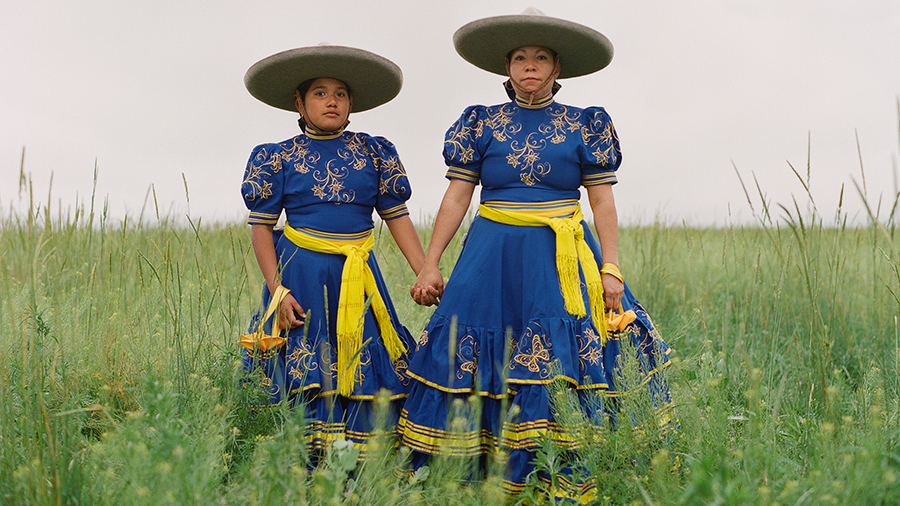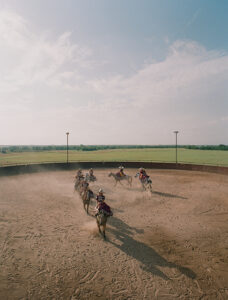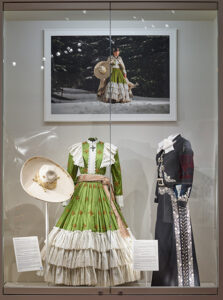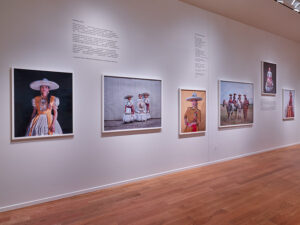
The National Cowgirl Museum and Hall of Fame honors the women of Mexican rodeo
By Charlotte Settle
Photos courtesy of the National Cowgirl Museum and Hall of Fame
The latest exhibition at Fort Worth’s National Cowgirl Museum and Hall of Fame, “Soldaderas to Amazonas: Escaramuzas Charras,” amplifies the voices of women in Mexican rodeo, or charrería.
Escaramuza charra, the sole women’s event in charrería, is deeply rooted in the tradition of the soldaderas — the unsung heroines of the Mexican Revolution. Escaramuza, meaning “skirmish,” pays homage to a legendary group of women who rode horses to distract oncoming enemies during battle. In the sport today, teams of eight equestrians execute intricate patterns at a full-speed gallop — all while riding sidesaddle and donning ornate, heavy dresses. Featuring a series of tight-knit crosses, technical spins and other refined maneuvers, escaramuza is often likened to ballet or synchronized swimming on horseback.
This exhibition, the first of its kind at the museum, reflects the organization’s commitment to honoring women of diverse backgrounds. To center Hispanic women’s experiences in this project and beyond, the museum formed an Hispanic advisory committee, Viva La Vaquera, last year.
“When you’re speaking about women within Western history, you have to make a lot of noise to get any kind of attention,” Diana Vela, the museum’s associate executive director of exhibits and education, said. “For women of color, it’s an even bigger hurdle.”

In the escaramuza sport today, teams of eight equestrians execute intricate patterns at a full-speed gallop — all while riding sidesaddle and donning ornate, heavy dresses.
The overlooked history of the soldadera persists in modern day charrería, in which the charro, or Mexican cowboy, is considered a hero and women are often dismissed. By celebrating the escaramuzas, who dedicate their lives to preserving their sport and heritage, this groundbreaking exhibition aims to reshape that narrative.
To delve deeper into escaramuza, Vela enlisted Paola Pimienta, U.S. ambassador for the coordination of charrería, as an adviser. In addition to actively competing in escaramuza, Pimienta’s responsibility as ambassador is to foster the growth of the sport in the U.S. and uphold its traditions.
“This project would not have happened without Paola,” Vela said. “She was instrumental in helping us secure object loans, connecting us with Mexican artisans, and helping us understand the nuances of the sport.”
“Soldaderas to Amazonas: Escaramuzas Charras” begins by showcasing one of the most distinctive elements of escaramuza — the attire. Featuring reconstructed soldadera uniforms, along with vibrant competition dresses donated from teams across the U.S., the gallery chronicles the evolution in dress from the Mexican Revolution to today.
Mexican artisans also donated intricately handcrafted sombreros, boots and rebozos, or meticulously woven shawls. Every inch of escaramuza attire must be made in Mexico and adhere to strict regulations — otherwise, the teams risk infractions during competition.
The gallery features mesmerizing video footage of Midlothian-based team and 2023 national champions, Escaramuza Tierra Azteca. Last year, Tierra Azteca advanced to the grand finale in Mexico — the primary goal of every American team — and placed second in the U.S. category.
In order for teams in the states to qualify for the grand finale, they must work significantly harder than their counterparts in Mexico, where charrería is revered as the national sport. Not only do U.S. teams have to pay costly shipping prices to acquire the proper uniforms, but if they make it to the Mexico grand finale, they also have to rent horses to ride.
“We don’t know these horses and they don’t know our routine,” said Amber Alcalá, team captain and founder of Tierra Azteca. “We only get to practice with them two to three times before we compete.”

“Soldaderas to Amazonas: Escaramuzas Charras” begins by showcasing one of the most distinctive elements of escaramuza — the attire. Featuring reconstructed soldadera uniforms, along with vibrant competition dresses donated from teams across the U.S., the gallery chronicles the evolution in dress from the Mexican Revolution to today.
Last year, California-based team, Escaramuza Flor del Campo B, made history as the first-ever U.S. team to advance to the final round of the grand finale in Mexico. To commemorate this milestone for the sport in America, the team lent its lavish uniforms to the gallery.
The second part of the exhibition, “Escaramuza, The Poetics of Home,” features breathtaking portraits by the award-winning photographer, Constance Jaeggi, a TCU graduate and competitive cutting horse rider. Jaeggi’s history as an equestrian inspires her body of work. Having had two prior solo shows at the National Cowgirl Museum, she was Vela’s top choice for this exhibition.
Jaeggi did not take her responsibility of photographing the escaramuzas lightly.
“I was very aware of my perspective as a white woman, and I needed to ensure I did this culture justice,” she said. Jaeggi traveled to several states, photographing escaramuza teams and building relationships with the women and learning everything she could about their practice.
“Constance understood the embodiment of who we are so well,” Pimienta said. “She was so well informed and really involved herself in the entire process.”
A prolific topic of conversation among the escaramuzas was the subjugation of women in charrería. To this day, competition panels are composed exclusively of men, and teams must be legitimized by a man in order to compete. Women in charrería didn’t have the right to vote in the organization until this year, and they are still only permitted to elect their own female representatives.
“The charros often think of us as their halftime show,” Alcalá said. “We make sure they know we’re not here to play — that they’re going to take us seriously and show us respect.”
Jaeggi’s gripping portraits exude confidence and power, perfectly encapsulating the escaramuzas’ unwavering ownership of their rightful place in charrería.
She encouraged the women to look directly into the lens — to confront the camera and reveal the grit beneath their pristine outward appearances.
“They’re beautiful, but more importantly, they’re proud and strong,” Jaeggi said. “The escaramuzas are larger than life.”
To accompany her portraits, Jaeggi commissioned original poems from the 2023 Texas poet laureate Ire’ne Lara Silva and the award-winning educator and UCLA Writing Project fellow Angelina Sáenz. Both writers drew inspiration from Jaeggi’s interviews and photos, crafting poignant language that captures the escaramuzas’ internal worlds.
“Ire’ne and Angelina were such a huge component in bringing these women’s stories and voices to life in the exhibition,” Jaeggi said.

The second part of the Cowgirl’s exhibition, “Escaramuza, The Poetics of Home” features breathtaking portraits by award-winning photographer Constance Jaeggi, a TCU graduate and competitive cutting horse rider.
One of Saenz’s poems, “I will die as a charra,” aptly describes escaramuza as a culture and a legacy. These women build their lives around charrería — spending every weekend at competitions, caring for their horses day in and day out, and practicing late into the evening after long days at work or school.
“We dedicate our lives to this,” Alcalá said. “We don’t get paid for it — we do it out of love and passion for the sport.”
The National Cowgirl Museum is offering a variety of additional programming to supplement the exhibition. This fall, visitors can attend Cowgirl Connections seminars with the Tierra Azteca team and Gladys Roldán-de-Moras — an escaramuza painter and one of the museum’s 2023 Hall of Fame honorees.
At a Cowgirl U Workshop, also coming this fall, attendees can enjoy an Hispanic-inspired activity, snacks and beverages while learning more about escaramuzas charras. “Conversations at the Cowgirl” podcast episodes, featuring Vela, Jaeggi and Pimienta, are also available to stream on all platforms.
When the exhibition closes in December, the museum plans to turn a portion of it into a semi-permanent collection. Vela will also rent Jaeggi’s portraits out to other venues to broaden the project’s reach.
“To my knowledge, there has not been another escaramuza exhibition of this scale anywhere else in the U.S.,” Vela said. “This will become part of the fabric of who we are.”
THE DETAILS
“Soldaderas to Amazonas: Escaramuzas Charras” is on display through December at the National Cowgirl Museum and Hall of Fame. For museum hours, rates and parking information, visit cowgirl.net.
